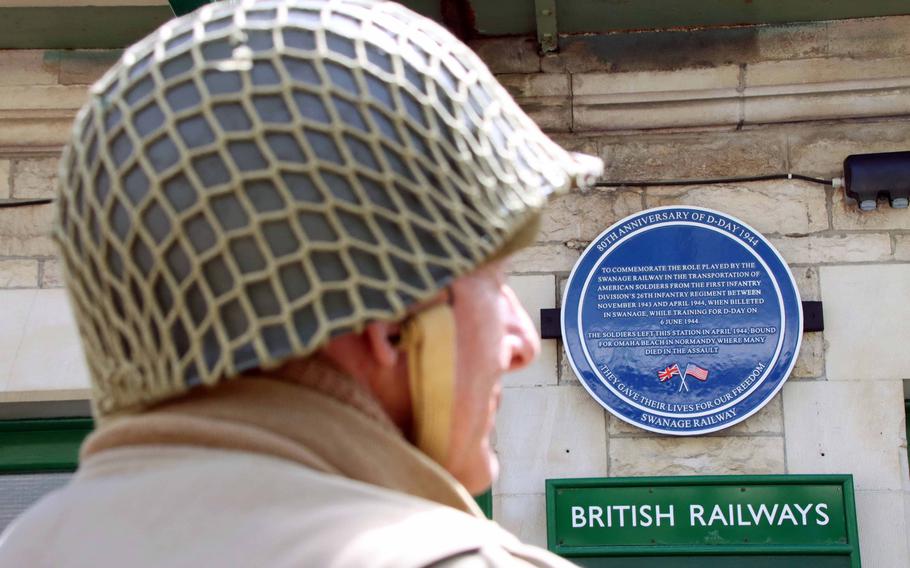
A plaque commemorating American soldiers who lived and trained in Swanage, England, during World War II was unveiled at Swanage railway station on Monday, May 27, 2024. (Andrew P.M. Wright)
For several months starting in late 1943, American soldiers with the 1st Infantry Division made their home away from home in Swanage, England, living and training there before leaving to invade Nazi-occupied France on D-Day.
Eighty years later, the English Channel town is honoring the soldiers with a plaque at the place where they began the first European leg of their journey to Omaha Beach in Normandy.
“Forevermore now, we will have a memorial at Swanage railway station to commemorate their bravery and what they did all those years ago,” said Robert Patterson, a spokesman for Swanage Railway Trust, which unveiled the plaque at a ceremony Monday.
Soldiers from the division’s 26th Infantry Regiment arrived in Swanage as part of the so-called “friendly invasion” of thousands of American troops who passed through the United Kingdom during World War II.
The people of Swanage played an indispensable role in bolstering the spirits and fortitude of the soldiers, according to 1st Infantry Division spokesman Lt. Col. Jefferson Grimes.
“The hospitality and care that the residents of Swanage afforded the soldiers of the 26th lessened the anxiety of being away from home during a difficult time,” Grimes said, adding that the division was “deeply honored” by the memorial.
The relationship between the soldiers and the local population was particularly amicable, according to historical accounts. Residents referred to the division by its nickname, the “Big Red One,” based on the color of the numeral on their unit patch.
“They became part of our community, part of our lives,” Patterson said.
Access to Swanage was restricted at the time, as it was part of a large training area that also included Studland, a few miles up the coast.
In April 1944, Supreme Allied Commander Gen. Dwight D. Eisenhower, British Prime Minister Winston Churchill and King George VI traveled to Studland to watch the combined power of Allied forces preparing for D-Day.
Shortly afterward, the 26th Infantry Regiment soldiers were given orders to leave Swanage by train. Weeks later, soldiers would embark on boats for Normandy and storm Omaha Beach on June 6.
The late Albert Weekes, a junior porter at the Swanage station, recalled years later how the troops had hung out of train windows as they were transported away.
“They were cheerful and gave me the thumbs up, and I smiled and returned the gesture,” Weekes was quoted as saying in a Swanage Railway Trust statement released ahead of the plaque’s unveiling. “I always wondered what happened to them and whether they came back.”
Casualties on Omaha Beach were the worst of any of the five landing beaches on D-Day. Some 2,400 American troops were killed, wounded or went missing there.
“The soldiers left this station in April 1944, bound for Omaha Beach in Normandy where many died in the assault,” the new plaque reads. “They gave their lives for our freedom.”
British D-Day veteran Peter Lovett, 99, unveiled the plaque during Monday’s ceremony, at which some people dressed in World War II military attire.
“It’s important that people remember and learn from the sacrifices of the past to defend freedom” Lovett said in remarks emailed to Stars and Stripes on Tuesday.
D-Day remains the largest amphibious invasion in history. It paved the way for the surrender of Nazi Germany less than a year later.
“This tribute not only reflects the bravery and sacrifice of our soldiers but also celebrates the profound support and camaraderie extended by the town of Swanage as these young men prepared for their critical role in D-Day 80 years ago,” Grimes said.